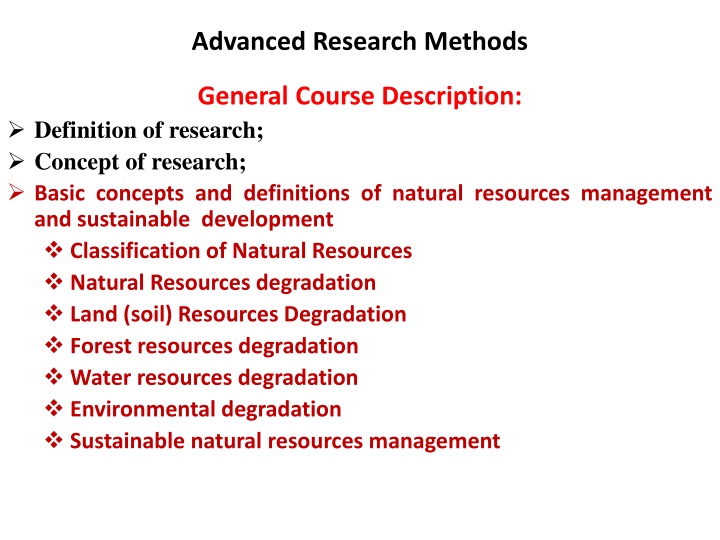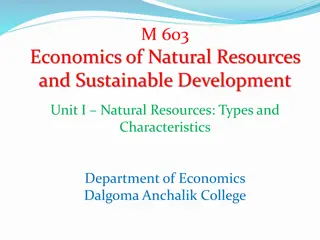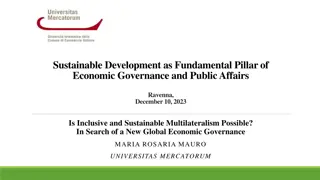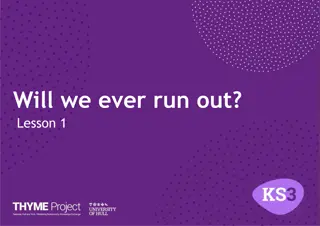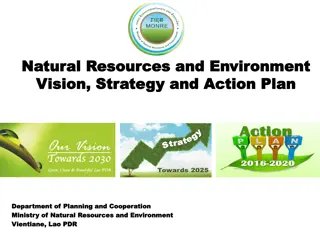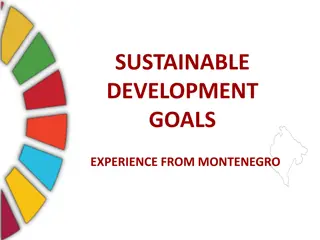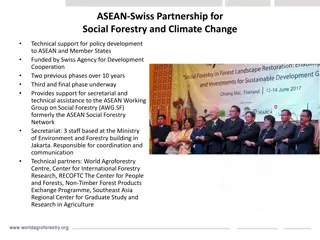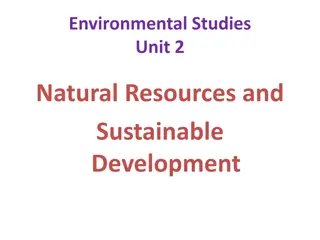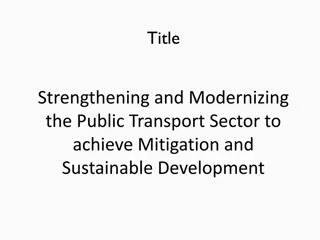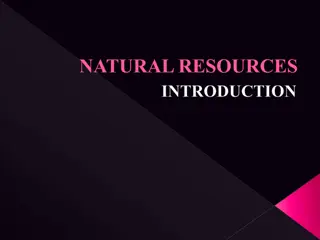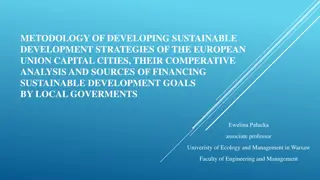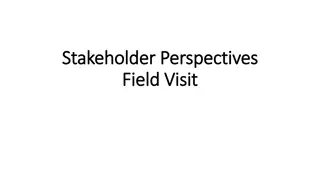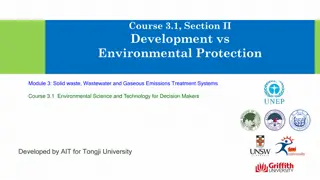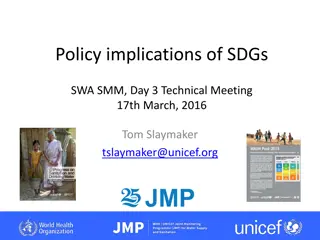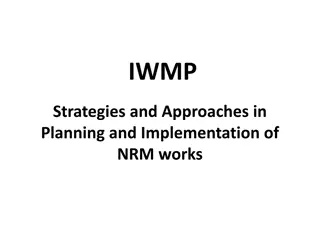Advanced Research Methods in Natural Resources Management and Sustainable Development
Explore the concepts of research in environment and climate change, experimental designs in natural resources, data analysis techniques, and interpretation methods. Enhance skills in scientific writing, hypothesis creation, literature search, and research proposal development. Gain insights into sustainable natural resources management and degradation issues.
Download Presentation

Please find below an Image/Link to download the presentation.
The content on the website is provided AS IS for your information and personal use only. It may not be sold, licensed, or shared on other websites without obtaining consent from the author.If you encounter any issues during the download, it is possible that the publisher has removed the file from their server.
You are allowed to download the files provided on this website for personal or commercial use, subject to the condition that they are used lawfully. All files are the property of their respective owners.
The content on the website is provided AS IS for your information and personal use only. It may not be sold, licensed, or shared on other websites without obtaining consent from the author.
E N D
Presentation Transcript
Advanced Research Methods General Course Description: Definition of research; Concept of research; Basic concepts and definitions of natural resources management and sustainable development Classification of Natural Resources Natural Resources degradation Land (soil) Resources Degradation Forest resources degradation Water resources degradation Environmental degradation Sustainable natural resources management
Concepts of research methods in Environment and Climate change Experimental designs and layout on natural resources Research trial and observations; Collection, processing and analysis of data; Measures of experimental variability; Research planning Problem identification Writing research proposals Experimentation Experimental designs for single-factor experiments in NRM Experimental designs for two-factor experiments in NRM Managing Field experiments Managing Greenhouse experiments Managing Laboratory experiments
Data analysis and Interpretation Missing data and Data trend analysis Data analysis : Analysis of variance (ANOVA) Mean separation Correlation and regression analysis t-test Chi square test Statistical packages (SPSS, SAS, MS-Excel) Interpretation Interpretation and summarization of results; Scientific report writing and developing a research proposal Presentation of research results
General Objectives To familiarize students about Research methodology, Develop and improve skills in scientific writing To evaluate and explain the relevance of published work in the context of their own research interests; Chosen topics and be able to create hypotheses of their own when literature doesn t exist. Effectively and systematically perform a literature search for primary research articles related to their own chosen topics
Conti. Your research method depends on The question that you wish to answer, and The philosophy that underpins your view of research The best place to start is introduction to research methods This sets out The basic principles of research design, and The role of the researcher. Overall to introduce about designing research which explains how to approach research, and what to think about in designing your research. It sets out some possible research approaches, including experimental and quasi-experimental research designs, survey
CHAPTER 1. THE PHILOSOPHY OF RESEARCH 1.1. Definitions of Research What is a research? Why a research / the need for research? 1.2. Differentiating research methods and research methodology
Definition of research Research is an essential and powerful tool in leading man Towards progress From its name, the word Research is comprises of two words = Re + Search. Meaning to search again. It is a systematic investigation or activity to gain new knowledge of the already existing facts. Research is responsible for bringing to light new knowledge. It is responsible for correcting the present mistakes, removing existing misconceptions and adding new learning to the existing fund of knowledge. Towards a new approach (i.e. from conventional to scientific) and new world Without systematic research there would have been very little progress.
Additional definitions As John W. Best; The secret of our cultural development has been research, pushing back the areas of ignorance by discovering new truths, which, in turn, lead to better ways of doing things and better products. Research is an endeavor / attempt to discover, develop and verify knowledge. It is an intellectual process that has developed over hundreds of years ever changing in purpose and form and always researching to truth. J. Francis Rummel, Research is: An honest, exhaustive, intelligent searching for facts and their meanings or implications with reference to a given problem. P.M. Cook : Research may be defined as a method of studying problems whose solutions are to be derived partly or wholly from facts.
Conti. W.S. Monroes : Research is considered to be the more formal, systematic intensive process of carrying on the scientific method of analysis. It involves a more systematic structure of investigation, usually resulting in some sort of formal record of procedures and a report of results or conclusion. John W. Best : Research comprises defining and redefining problems, formulating suggested solutions, collecting, evaluating data, making deductions and reaching conclusions and at last careful testing the conclusions to determine whether they fit the formulated hypothesis. hypothesis organizing or and
Conti. Clifford Woody: Research is a systematic effort to gain new knowledge. P.V. Younge : Scientific research leads to progress in some field of life to fined new products, new facts, new concepts and new ways of doing things are being found due to ever-increasing significant research in the physical, the biological, the social and the psychological fields.
Researches are Considered as a combination of those activities which are removed from day to day life and are pursued by those persons who are gifted in intellect and sincere in search of knowledge. But it is not correct to say that the research is restricted to such type of persons, however, it is correct to say that major contribution of research comes from highly gifted and committed workers Because it needs a comprehensive approach's through employing various discipline Thus the research is not at all mysterious and is carried on by hundreds of thousands of average individuals.
Conti. Research is also considered as the application of scientific method in solving the problems. It is a systematic, formal and intensive process of carrying on the scientific method of analysis. There are many ways of obtaining knowledge. They are intuition, exposure, and authority, logical manipulation of basic assumptions, informed guesses, observation, and reasoning by analogy. E.g. Aquifer system can be compared to bank account Groundwater in the aquifer is analogous to the many in the account One of the branches of research known as empirical research is highly goal-oriented technique.
Purpose of Research The purpose of research is to discover answers to questions through the application of scientific procedure. The main aim of research is to find out the truth which is hidden and which has not been discovered as yet. Though each research study has its own specific purpose, some general objectives of research below: To gain familiarity with a phenomenon or to achieve new insights into it. (Studies with this object in view are termed as exploratory or formative research studies). To portray accurately the characteristics of a particular individual, situation or a group. (Studies with this object in view are known as descriptive research studies). To determine the frequency with which something occurs or with which it is associated with something else. To test a hypothesis of a causal relationship between variables. e.g. relation between groundwater-climate and human impacts
Characteristics of Research Research has its own characteristics: Research is directed toward the solution of a problem. Research requires expertise. Research emphasizes generalizations, principles, or theories that will be helpful in predicting future occurrences. Research is based upon observable experience or empirical evidences. Research demands accurate observation and description. the development of
Research involves gathering new data from primary or first- hand sources or using existing data for a new purpose. is characterized by carefully designed procedures that apply rigorous analysis. involves the quest for answers to un-solved problems. strives to be objective and logical, applying every possible test to validate the procedures employed the data collected and the conclusions reached. is needs carefully recorded and collected data.
Research steps Research process consists of series of actions or robust steps These actions or steps are: 1. Formulating the Research Problem At the very outset, the researcher must decide the general area of interest or aspect of a subject matter that he would like to inquire into and then research problem should be formulated. Usually, begins with problem observations followed by Identification of topics relevant to the observed problems
Problems The problems lie everywhere around us. They even lie at our door step and in our backyards. Human nature is so complicated, that A problem solved for one individual may still exist for another individual, A problem solved for one class/ school/teacher/ situation/ system/time etc., still remains A problem solved for the time being may reappear with a lapse of time. We become habitual of living in the age of problems i.e. we are so much surrounded by the problem that we suffers from , problem blindness . But in order to solve the problem or making research we need to demarcate the problem.
Selection of problems Selection of problem is not the first step in research but identification of the problem is the first step in research. Selection of problem is governed by reflective thinking. It is wrong to think that identification of a problem means to select a topic of a research or statement of the problem. A topic or statement of the problem and research problem are not the synonyms but they are inclusive / or comprehensives. The problem concerns with the functioning of the broader area of field studied, whereas a topic or title or statement of the problem is the verbal statement of the problem. The topic is the definition of the problem which delimits or pin points the task of a researcher. e.g. the problem is groundwater deteriorations, then come to the title and topics
Conti. It is the usual practice of the researcher that they select the topic of the study from different sources especially from research abstracts. They do not identify the problem, but a problem is made on the basis of the topic. It results that they have no active involvement in their research activities, whatever, they do, do mechanically.
Definitions of the Problem: The obstacles which hinder our path are regarded as problem. Different definitions of the problem by different authors are given below; John Geoffery: Problem is the obstacle in the path of satisfying our needs. John. G. Tornsand : Problem is a question which is to be solved. Whitney: To define a problem means to put a fence around it, to separate it by careful distinctions from like questions found in related situations of need. J.C. Townsend: A problem is a question proposed for a solution generally speaking a problem exists when there is a no available answer to same question. F.N. Kerlinger: A problem is an interrogative sentence or statement that asks: What relation exists between two or more variables?
Conti. Monero and Engelhart: To define a problem means to specify it in detail and with precision each question and subordinate question to be answered is to be specified, the limits of the investigation must be determined. Frequently, it is necessary to review previous studies in order to determine just what is to be done. Sometimes it is necessary to formulate the point of view or educational investigation is to be based. If certain assumptions are made, they must be explicitly noted. theory on which the
Identification of a Research Problem: Steps to be followed in identifying a research problem; Determining the field of research in which a researcher is powerful to do the research work. The researcher should develop the mastery on the area or it should be the field of his specialization. He should review the research conducted in area to know the recent trend and studies are being conducted in the area.
Conti. On the basis of review, he should consider the priority field of the study. He should draw an analogy and insight in identifying a problem or employ his personal experience of the field in locating the problem. He may take help of supervisor or expert of the field. He should pin point specific aspect of the problem which is to be investigated.
Sources of the Problem: The classroom, school, home, community and other agencies of education are obvious sources. Social developments and technological changes are constantly bringing forth new problems and opportunities for research. Record of previous research such specialized sources as the encyclopedias of educational, research abstracts, research bulletins, research reports, journals of researches, dissertations and many similar publications are rich sources of research problems.
Problem source Text book assignments, special assignments, reports and term papers will suggest additional areas of needed research. Discussions-Classroom discussions, exchange of ideas with faculty members and fellow scholars and students will suggest many stimulating problems to be solved, relationships, academic discussions and constructive academic climate are opportunities. Questioning attitude: A questioning attitude towards prevailing practices and research oriented academic experience will effectively awareness. seminars and close professional especially advantageous promote problem
Conti. The most practical source of problem is to consult supervisor, experts of the field and most experienced persons of the field. They may suggest most significant problems of the area. He can discuss certain issues of the area to emerge a problem. Although research problems should not be assigned or they should not be proposed and allotted by a guide but consultation with the more experienced faculty member or research worker is a desirable practice. One of the most important functions of the research guide is to help the student clarify his thinking, achieve a sense of focus and develop a manageable problem from one that may be vague and too complex.
Statement of the Problem: Kerlinger has identified following three criteria of good problem statements; A problem should be concerned with relation between two or more variables. It should be stated clearly and unambiguously in question form . It should be amenable/ or willing or agreeable to empirical testing. Meeting these criteria in his problem statement will result, in a clear and summarized idea of what the researcher wants to do. This sets the state for further planning.
Research Assumptions Any research and its method incorporate several assumptions and approximations that may not represent the real world particularly with parameter estimation, recharge estimation, data inadequacy and errors. Because it is quite difficult to represent all valuable hug data sets accurately or it is not feasible to feed the complexities of the natural system in to a computer model. Instead simplifying the actual system being examine and organizes the data via inclusions of assumptions is necessary so the system can be analyzed effectively. e.g. Model conceptualizing organize the associated field data so that the system can be analyzed more easily in a better understanding manner of site condition that aids to simplify the field problem and However, apart from to data adequacy and quality, skills and level of details; reliability of the result depends on the dimension of the designed assumptions
Objectives of Assumptions about the Problem: 1. To make the research work feasible. 2. To delimit the scope of the problem. e.g. aquifer boundary conditions 3. To establish the proper frame of reference e.g. model framework Aspects of Delimiting/ or delineating or bounding / demarcating a Problem: 1.Bound to certain variables that should be mentioned clearly in the problem. 2.Bound to the area or level as primary level, secondary level, college or university level. 3.Bound to size of sample, considering the time, energy and money.
Conti. 4. Delimited to the best method only. 5. Delimited to the best available tool for measuring the variable. E.g. available model type, skill or familiarize with the model 6. Delimited to the most appropriate techniques. 7. Other delimitations particular to a problem. As the above delimitations help the researcher for conducting the study, the findings of studies also confine to these delimitations.
Evaluation of the Problem: When considering a problem a researcher is required to ask himself a series of questions about it. These are helpful in the evaluation of the problem on the basis of personal suitability of the researcher and social value of the problem. Following questions must be answered affirmatively before the study is under Taken: 1. Is the Problem Researchable? 2. Is the Problem New?
Conti. 3. Is the Problem Significant? 4. Is the Problem Feasible for the Particular Researcher? In order to be feasible, a problem should agree with the following: a) Research competencies of the Researcher b) Interest & enthusiasm / eagerness of the Researcher c) Financial consideration in the Project d) Time requirement for the Project e) Administrative considerations in the Project.
2. Extensive Literature Survey: Once formulated the problem; the researcher should undertake extensive literature survey connected with the problem. For this purpose, the abstracting and indexing journals and published or unpublished bibliographies are the first place to go to academic proceedings, government reports, books etc. must be tapped depending on the nature of the problem. journals, conference Review literature relevant to their field or interests and determine how research findings are useful in forming their understanding of their work, social, local and global environment.
3. Development of Working Hypothesis: After extensive literature survey, researcher should state in clear terms the working hypothesis or hypotheses. e.g. what are the possible derivers for decaling of water table over an area under consideration? Or possible factors led to dry surface water (lake, etc.) Working hypothesis is tentative assumption made in order to draw out and test its logical or empirical consequences. It s very important or it provides the focal point for research.
Formulation of Hypothesis The word hypothesis consists of two words Hypo + Thesis. Hypo means tentative or subject to the verification. Thesis means statement about solution of the problem. Meaning of the term hypothesis is a tentative statement about the solution of the problem. Hypothesis offers a solution of the problem that is to be verified empirically and based on some rationale. Again, hypo means the composition of two or more variables which are to be verified and thesis means position of these variables in the specific frame of reference.
There are a number of definitions about hypothesis J.S. Mill: Any supposition which we make in order to endeavor to deduce conclusions in accordance with facts which are known to be real under the idea that if the conclusions to which the hypothesis leads are known truths, the hypothesis itself either must be or at least likely to be true. Lundberg: A hypothesis is a tentative generalization the validity of which remains to be tested. In its most elementary stage the hypothesis may be any hunch, guess, imaginative idea which becomes basis for further investigation.
Definitions of hypothesis Barr and Scates: A hypothesis is a statement temporarily accepted as true in the light of what is, at the time, known about a phenomenon, and it is employed as a basis for action in the search for new, truth, when the hypothesis is fully established, it may take the form of facts, principles and theories. Gorge J. Mouly: Hypothesis is an assumption whose testability is to be tested on the basis of the compatibility of its implications with empirical evidence and previous knowledge.
Functions of Hypothesis: Hypothesis may have several functions (i) It is a temporary solution of a problem concerning with some truth which enables an investigator to start his research works. (ii) It offers a basis in establishing the specifics what to study for and may provide possible solutions to the problem. (iii) It may lead to formulate another hypothesis. (iv) A preliminary hypothesis may take the shape of final hypothesis.
Conti. (v) Each hypothesis provides the investigator with definite statement which may be objectively tested and accepted or rejected and leads for interpreting results and drawing conclusions that is related to original purpose. (vi) It sensitizes the researcher so that he should work selectively, and have very realistic approach to the problem. (vii) It offers the simple means for collecting evidences for verification.
Generally, Without hypothesis, a research is unfocussed research and remains like a random empirical wandering.
Forms of Hypothesis: (i) Question form: A hypothesis stated as a question represents the simplest level of empirical observation. It fails to fit most definitions of hypothesis. It frequently appears in the list. There are cases of simple investigation which can be adequately implemented by raising a question, rather than dichotomizing the hypothesis forms into acceptable / reject able categories.
Conti. (ii) Declarative Statement : A hypothesis developed as a declarative statement provides an anticipated relationship or difference between variables. Such a hypothesis developer has examined existing evidence which led him to believe that a difference may be anticipated as additional evidence. It is merely a declaration of the independent variables effect on the criterion variable. (iii) Directional Hypothesis : A directional hypothesis connotes an expected direction in the relationship or difference between variables. This type of hypothesis developer appears more certain of anticipated evidence. If seeking a tenable hypothesis is the general interest of the researcher, this hypothesis is less safe than the others because it reveals two possible conditions. First that the problem of seeking relationship between variables is so obvious that additional evidence is scarcely needed. Secondly, researcher has examined the variables very thoroughly and the available evidence supports the statement of a particular anticipated outcome.
Conti. (iv) Non Directional Hypothesis or Null Hypothesis: This hypothesis is stated in the null form which is an assertion that no relationship or no difference exists between or among the variables. Null hypothesis is a statistical hypothesis testable within the framework of probability theory. It is a non-directional form of hypothesis.
Conti. There is a trend to employ or develop null hypothesis in research in most of the disciplines. A null hypothesis tentatively states that on the basis of evidence tested there is no difference. If the null hypothesis is rejected, there is a difference but we do not know the alternative or the differences. In this the researcher has not to anticipate or give the rational for the declaration or directional form. It does not make researcher biased or prejudiced. you may be objective about the expected outcomes of the research or findings.
Identifications of variables and their types A Variable is a concept which can take on different quantitative values. A Variable is a quantity which can vary from one individual to another. The quantity which can vary from person to person. It is any feature or aspect of an event, function or process that, by its presence and nature, affects some other event or process, which is being studied. For example; height, weight, income, age etc. The main focus of the scientific study is therefore, to analyze the functional relationship of the variables. Types of variables (i) Continuous Variable: It is that which can assume any numerical value within a specific range. e.g. 10 - 100 (number. Unit or )
(ii) Discrete Variable: A variable for which the individual values fall on the scale only with distinct gaps is called a discrete variable. e.g. 4 8; 8 12; 12 16 (iii) Dependent Variable If one variable depends or is a consequence of other, it is termed as dependent variable. Criterion variable is the basis on which the effectiveness of the experimental variable is studied. e.g. groundwater level depends on Human effect, Rainfall, geology, tectonic, Rainfall also depends on Temperature, wind, humidity, location, . (iv) Independent Variable or Experimental Variable: The variable that is antecedent to the dependent variable. The variable whose effect is going to be known
(v) Controlled Variable: The effectiveness of an experimental variable is examined by comparing with other variable e.g. Groundwater level as controlled for model calibration (vi) Confounding Variable: Those aspects of study or sample, that might influence the dependent variable (outcome measures), and whose effect may be confused with the effects of the independent variable. Especially if more variables are difficult to simulate E.g. land use in GW level (difficult to model), irrigation back water on recharge Two types: Intervening and extraneous variable. (vii) Intervening Variable: There are a number of abstract variables in educational/social experiments, which intervene the effect of experimental or criterion variable. For controlling intervening variable appropriate research design should be used. Intervening variables are hard if not impossible, to observe because they usually have to do with an individual s feelings like stress, fatigue, excitement .. etc.
(viii) Extraneous Variable: Independent variables that are not related to the purpose of the study, but may affect the dependent variable e.g. watershed management, back recharge from irrigation Whatever effect is noticed on dependent variable as a result of extraneous variable(s) is technically described as an experimental error. A study must always be so designed that the effect upon the dependent variable is attributed entirely to the independent variables and not to some extraneous variable(s). When the dependent variable is not free from the influence of extraneous variable(s), the relationship between the dependent and independent variable is said to be confounded by an extraneous variable(s).
Conti. Actually this is a statistical hypothesis which is self- explanatory. Null hypothesis means zero hypotheses. A researcher has not to do anything in developing it. While research hypothesis is second step in the process of reflective thinking. A null hypothesis in an appropriate form is order to accommodate the object of inquiry for extracting this information. It does not necessarily reflect the expectations of the researcher so much as the utility of the null form as the best fitted to the logic of chance in statistical knowledge or science. It is the no difference form, i.e. there is no difference or relationship between or among variables under certain conditions.
